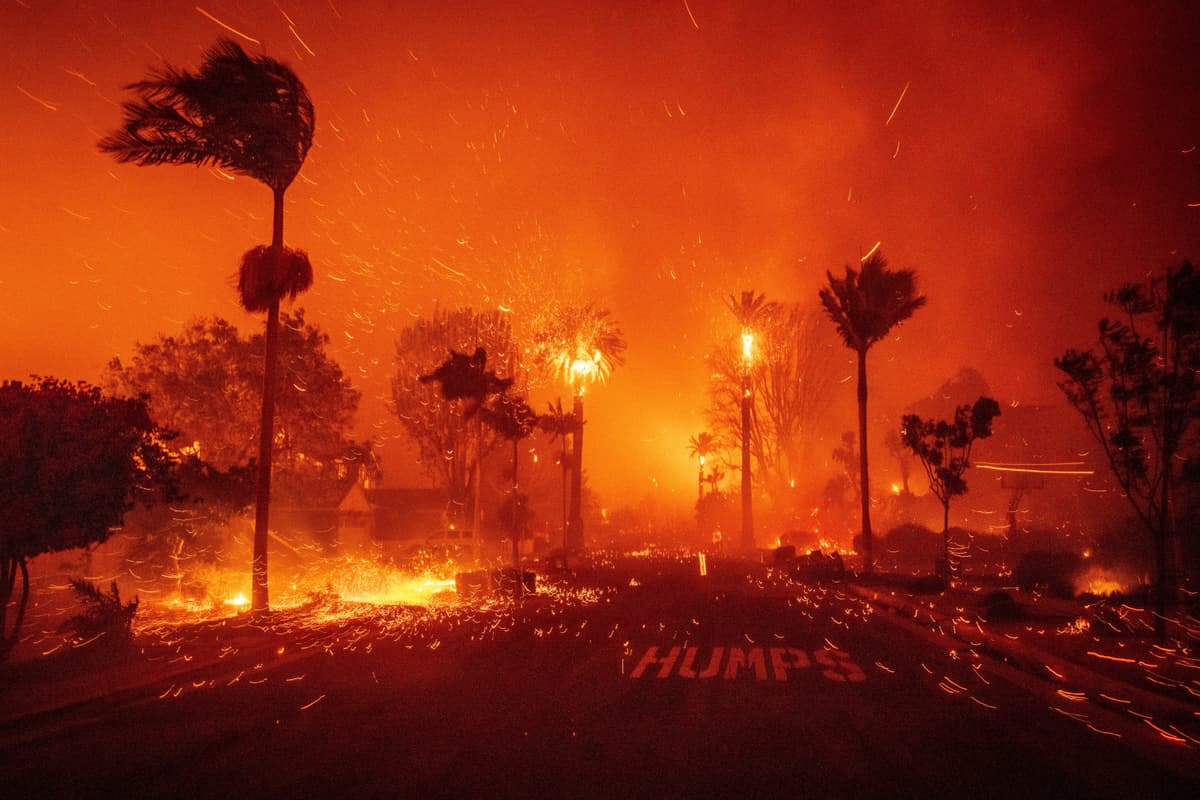Los Angeles Burns
What is at stake here is the entire mysterious history, love and disenchantment intertwined, of Americans and their cities.

One thinks of Dante hurling his damned into a burning hell.
Of Empedocles’ volcano, which is, for Friedrich Hölderlin, the image of a world in eruption and heading towards its end.
Of James Joyce wandering his hero through a maze of flames, toxic smoke, and lost souls. One thinks, since it is the place in the world where everything begins in images and ends in reality, of the disaster films produced by Hollywood that have pre-scripted the ongoing tragedy.
*
One thinks of Pompeii buried by a deluge of lava.
Of Jericho, Hazor, or Sodom reduced to pools of fire.
Of the Library of Alexandria, whose gigantic, uncontrollable, devouring flames, according to Denis Diderot, marked an entry into the dark ages. One thinks of the fire at Notre-Dame, where it is the beating heart of France that, at a gradient close to the spiral of fate, almost collapsed entirely with its stack of centuries and treasures.
*
In reality, it is all of this and worse.
The burning city is Los Angeles, the spiritual capital of California.
It is the point where, thanks to the ultimate western shift that has re-centered the country around the Silicon Valley and Pacific campuses, a dream of perpetual summer has magnetized the national narrative of the United States.
What is burned are not only thousands of hectares of land and pavement, hundreds of thousands of lives whose humble possessions have been reduced to ash, billions of dollars in wealth and power, chimerical lives of stars, tycoons, and other icons, but also the high places of American, and thus global, pastoralism.
Not to mention the Getty Villa Museum, this temple of art and its universal memory, which is besieged at Pacific Palisades and could, in turn, be sacrificed by fire.
*
Religious minds – and they are a multitude in the realm of neo-evangelism! – see a sign and a punishment in this disaster.
When they are radical ecologists, they blame big business, responsible for climate disruption, the vegetation gone wild and resembling a mess, unlimited urban growth, and water shortages.
When they are Trump supporters, they attack the wicked woke and the symmetrical excess that led them, to save the smelts of the rivers, to drain the firefighters’ strategic reserves.
In both cases, there is a devil pulling the strings that stir this hell.
And the storm of fire is structured like a word that, as deafening as it may be, lets a few words slip addressing this double and symmetrical hubris: “Remember, oh fanatics of an American dream whose principle remains, on both the left and the right, creative destruction, that is to say, in the end, joyful apocalypse, dear to Joseph Schumpeter, your oracle – remember that the earth is fragile, that humanity’s presence on it hangs by a thread, and that the world is allocated to them on the condition that they do not forget that there are forces greater than they and that it is appropriate to inhabit it with the humility preached by Seneca after the first fire of Alexandria.”
*
But should we make the elements speak like this? Are things not more prosaic and human than that?
I think of Jean-Paul Sartre’s astonishment, during his first trip in the US, in front of these precarious cities, quickly built and quickly abandoned, near a mining basin or a gold mine, doomed to a ghost town destiny.
I hear myself exclaiming, in “American Vertigo,” in front of the desolation presented in Buffalo and the other Great Lakes cities that had become deserted and a lunar Babylon, agonizing under the weight of their young ruins: “They shoot great cities, don’t they?”
I re-read what I said about a certain city in Florida that had been, after the passage of yet another hurricane, rebuilt identically, with the same prefabricated buildings, sometimes the same trolleys, placed in the middle of a field, cobbled together, and with nothing to prevent it from being swept away again, in the same breath of apocalypse, when the next Lili, Isidore, or Allison arrived.
Or, finally, Los Angeles, this poorly constructed, poorly irrigated city, wedged between the wall of the Pacific and the Santa Monica mountains, drowned in this mixture of smoke and fog, that was called smog and which already made it, contrary to legend, one of the most polluted cities in America – I think back, yes, to this “anti-city” where everyone lived, with a mix of fatalism and terror, in anticipation of a Big One whose version, seismic or incendiary, was uncertain, but whose arrival was not doubted: “a city built like this is a city, I wrote, of which one can only, alas, predict its imminent death.”
We are nearly there. And what is at stake here, beyond the witch trials, is the entire mysterious history, love and disenchantment intertwined, of Americans and their cities.
